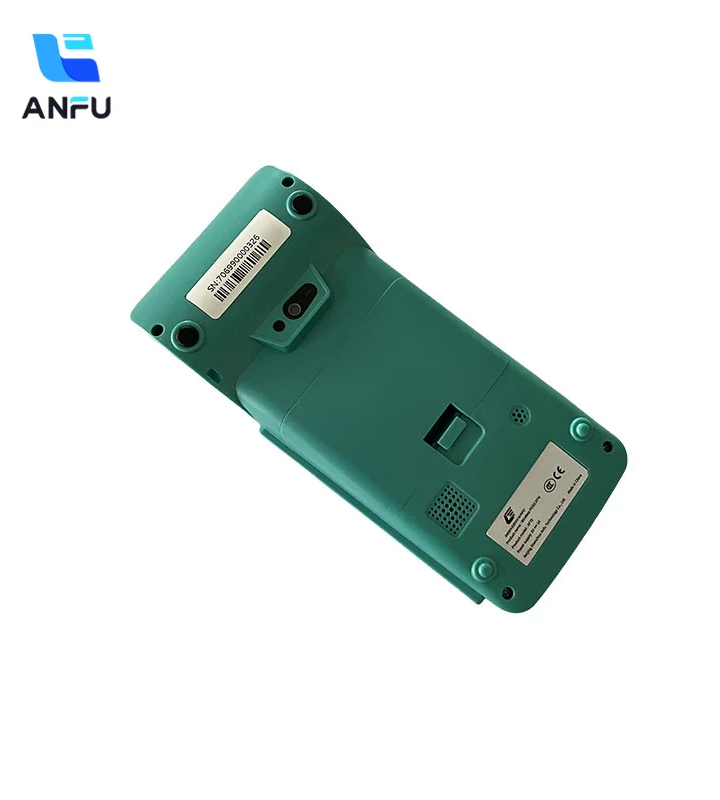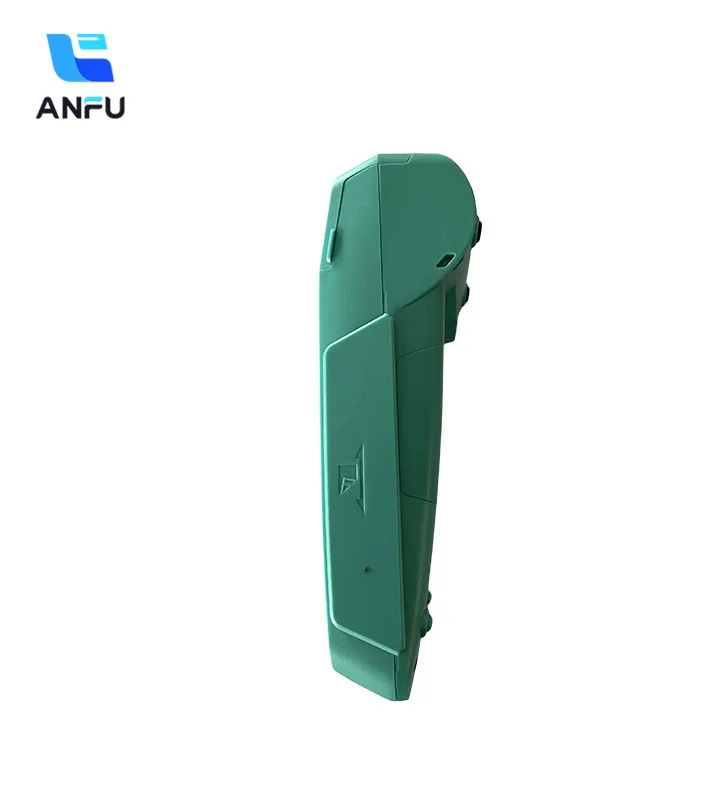
Veiligheid is van het allergrootste belang in de wereld van betalingsverwerking, en de Smart Android POS neemt deze verantwoordelijkheid serieus. Met ingebouwde encryptieprotocollen, EMV-chiptechnologie en PCI-naleving, zorgt dit apparaat ervoor dat elke transactie met het hoogste beveiligingsniveau wordt uitgevoerd. Handelaren kunnen er zeker van zijn dat gevoelige klantgegevens worden beschermd tegen mogelijke bedreigingen zoals fraude en inbreuken op gegevens. Door de veiligheid prioriteit te geven,Smart Android POSHet is een belangrijke factor in de ontwikkeling van de Europese markt voor de verkoop van producten.

Het evolueert en terwijl de technologie blijft veranderen, blijft het slimme Android-verkoopsysteem vooruit in termen van innovatie. Door een software te hebben die kan worden geüpgraded en firmware mogelijkheden, wordt het gebruikt om andere bedrijven voor te zijn door nieuwe trends en technologieën te adopteren die kunnen opduiken. Deze Smart Android POS kan zich integreren met virtuele realiteit winkelervaringen, cryptocurrency betalingen ondersteunen of kunstmatige intelligentie gebruiken voor voorspellende analyses. De toekomst van het bedrijf is met dit soort investeringen veilig, omdat verandering onvermijdelijk is in een snel veranderende omgeving waarin bedrijven hun concurrenten voortdurend moeten blijven voorblijven.

In plaats van een gewone kassa, heeft de Smart Android POS een breed scala aan functies die zijn ontworpen om de verbetering van bedrijfsoperaties te ondersteunen. Apparaten zoals; voorraadbeheer, personeelsplanning, verkoopanalyses en klantrelatiebeheer worden door dit product versterkt om hun operaties te verbeteren. Handelaren kunnen gebruikmaken van dit apparaat voor realtime toegang tot belangrijke informatie die hen zal helpen bij besluitvormingsprocessen, het identificeren van trends en het nauwkeuriger voorspellen van de vraag. De slimme Android POS is een hulpmiddel dat de verwachtingen van klanten mogelijk maakt door alle kernfuncties in één platform te integreren, waardoor bedrijven hun workflow gemakkelijker kunnen beheren en de administratieve lasten in het algemeen veilig kunnen verminderen, wat de algemene efficiëntie verbetert en meer ruimte creëert voor groei door innovaties.

De Smart Android POS is een innovatief product dat het concept van verkooptechnologie in het veld zal herdefiniëren. Het werkt op het Android-platform dat up-to-date is en organiseert een reeks functies binnen een vriendelijke interface. Dit apparaat heeft een slanke uitstraling die een kleurrijk touchscreen-display bevat, waardoor gebruikers gemak hebben bij het navigeren door de functies. Het heeft talrijke functies, zoals voorraadbeheer, verkoopanalyse en klantrelatiebeheer, zodat bedrijven efficiënt kunnen functioneren en hun groei kunnen stimuleren. De ingebouwde connectiviteitsopties, waaronder Wi-Fi, NFC en Bluetooth, maken het mogelijk om transacties sneller te verwerken onder de beveiligingsmaatregelen die de hedendaagse klantenservice vereist. Bovendien is de aanpassingsmogelijkheid niet beperkt tot traditionele detailhandel, maar vindt het ook toepassing in Daarnaast ondersteunt het contactloze betalingen zoals het scannen van QR-codes en de integratie van mobiele portemonnees op basis van de nieuwste trends in betalingsverwerking, waardoor het compatibel is met verschillende voorkeuren onder klanten. Dat betekent dat, of u het nu zelfstandig of samen met andere geïntegreerde systemen zoals het POS-ecosysteem wilt gebruiken, deze specifieke slimme Android POS innovatie-efficiëntie en betrouwbaarheid tot werkelijkheid heeft gebracht en zo een precedent heeft gelegd voor de digitale tijdperk-verkooptechnologie.

Aan de andere kant is het gebruiksvriendelijk, intuïtief en maakt het eenvoudige navigatie mogelijk, wat ervoor zorgt dat klanten minder tijd in de rij doorbrengen. Bovendien heeft het systeem digitale bonnen die bedrijven in staat stellen om op een hoger niveau verbinding te maken met hun gewaardeerde klanten; daardoor kunnen ze loyaliteitsprogramma's onderhouden en gepersonaliseerde promoties aanbieden. Dit maakt Smart Android POS uniek en anders dan andere in de concurrerende markt door langdurige relaties met de doelgroep te creëren via verbetering van de klantervaring.

Opgericht in 2015, Beijing Shenzhou Anfu Technology Co., Ltd is een hightech onderneming die zich richt op het ontwerp, de ontwikkeling en de verkoop van modules en beveiligingsterminalproducten. Onze onderneming heeft talrijke certificeringen behaald, waaronder certificering als hightech onderneming, certificering van acceptatieterminalproducten voor UnionPay-kaarten, certificering als softwareonderneming en ISO9001:2015 certificering van het kwaliteitsmanagementsysteem.
Met een uitgestrekte fabriek van 35.000 vierkante meter gelegen in Tianjin, hebben we 15 productielijnen die zijn gewijd aan MPOS (Mobile Point of Sale) systemen. Ons personeel bestaat uit meer dan 700 geschoolde individuen die zich inzetten voor het leveren van innovatieve oplossingen om te voldoen aan de veranderende behoeften van onze klanten.
Ons uitgebreide productassortiment omvat Smart Android POS, Smart Mobiele Betaling Terminal, Handheld POS Machine, POS Android Terminal, POS Handheld Terminal, Smart POS Terminal, Mini POS Machine, Draadloze POS Machine, Android-gebaseerde POS Machine, en Traditionele POS Machine. Bij Shenzhou Anfu zijn we toegewijd aan uitmuntendheid, en zorgen we voor superieure kwaliteit, betrouwbaarheid en veiligheid in al onze producten.
Onze Slimme Android POS, Handheld POS Machine en andere producten bieden een alles-in-één oplossing voor uw POS-behoeften. Met uitgebreide hardware-opties en veelzijdige software-integratiemogelijkheden integreren onze systemen naadloos in uw bestaande opstelling, wat zorgt voor een soepele werking vanaf dag één.
Ondersteund door een rigoureus productieproces en strenge kwaliteitscontrolemaatregelen, garanderen onze producten ongeëvenaarde kwaliteit en betrouwbaarheid. Elke stap van het productieproces voldoet aan de hoogste normen, en onze producten ondergaan grondige kwaliteitscontroles om superieure prestaties en duurzaamheid te waarborgen.
Als een fabriek-directe fabrikant bieden we concurrerende prijzen zonder concessies te doen aan de kwaliteit. Onze gestroomlijnde productieprocessen stellen ons in staat om de kosten effectief te beheersen, waardoor we de besparingen aan onze klanten kunnen doorgeven. Neem contact op met ons verkoopteam voor gedetailleerde prijsinformatie die is afgestemd op uw specifieke vereisten.
Geniet van moeiteloze installatie en opzet met onze producten, ondersteund door uitgebreide trainingsprogramma's en proactieve onderhoudsondersteuning. Van de initiële installatie tot doorlopend onderhoud, Shenzhou Anfu zorgt voor een soepele ervaring, zodat u zich op uw bedrijf kunt concentreren.
De Smart Android POS biedt een modern, Android-gebaseerd platform met intuïtieve touchscreeninterfaces, robuuste connectiviteitsopties en geavanceerde functies zoals voorraadbeheer en verkoopanalyses, die traditionele transactieprocessen revolutioneren.
Uitgerust met draadloze connectiviteitsopties zoals Wi-Fi, Bluetooth en NFC, stelt de Smart Android POS bedrijven in staat om transacties overal te verwerken, van winkels tot buitenevenementen, en voldoet aan diverse zakelijke behoeften en verbetert de operationele flexibiliteit.
Met zijn slanke ontwerp en veelzijdige functionaliteit stelt de Smart Android POS bedrijven in staat om snellere transacties aan te bieden, diverse betaalmethoden te ondersteunen en toegang te krijgen tot realtime klantgegevens, wat leidt tot gepersonaliseerde ervaringen en verbeterde tevredenheid.
De Smart Android POS maakt gebruik van geavanceerde versleutelingsprotocollen, EMV-chiptechnologie en PCI-naleving om transacties en klantinformatie te beschermen, wat zorgt voor robuuste beveiliging tegen potentiële bedreigingen zoals fraude en datalekken.
